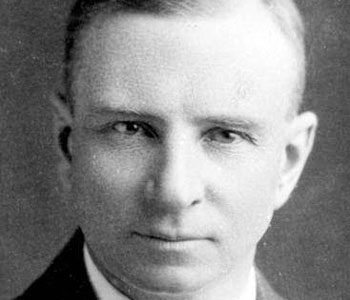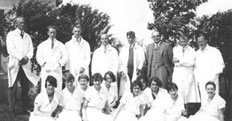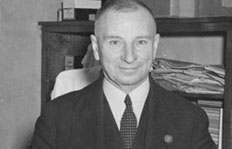Dr. J.J. (Johnny) Ower, 1885-1962
September 18, 2013

A physician who responded to Germany's first chlorine gas attack during World War 1, the first Professor and Chair of the University of Alberta's Department of Pathology and later Dean of Medicine, Dr. J.J. Ower played a key role in Alberta medicine over several decades.
Dr. J.J. Ower was one of the McGill graduates that led the University of Alberta (U of A) Faculty of Medicine from 1913–59. He trained at McGill, the Montreal General Hospital and the Mallory Institute in Boston, choosing pathology for his medical specialty because “he knew he preferred patients who couldn’t talk back, to ones who cried on his shoulder.”
A “man of singular directness, with energy of mind, sincerely and uncompromising in his standards, yet with a natural charm and boyish spirit” (Dr. Earle P. Scarlett).
Dr. Ower during World War I
In 1914, Dr. Ower was on his way to Germany to study in the Aschoff Laboratory when England declared war. He had joined the 5th Field Ambulance in Montreal and was called up to join the McGill-staffed #1 Canadian General Hospital. In December 1914, Dr. Ower was assigned to the hospitals laboratory under Dr. Allan C. Rankin to treat the meningococcal meningitis outbreak among the Canadian soldiers.
Transferred to France in April 1915, he responded to the first chlorine gas attack, which caused 1,200 casualties who were brought to the hospital with pneumonia and pulmonary edema. A diarist, he recorded that during the war, only one-third of the casualties brought to the hospital were wounded from shrapnel and shell injuries, while two-thirds were admitted with illnesses.
By 1918, his hospital was specializing in hip fractures using Thomas splints and traction. That summer, whole battalions of 1,000 men or more would arrive with the newly discovered Spanish flu.
Returning to Alberta
Dr. Ower arrived in Edmonton in 1919 as the first Professor and Chairman of the University of Alberta’s Department of Pathology, as well as seropathologist at the provincial laboratory. He was also the surgical pathologist at the Misercordia and the Edmonton General hospitals for decades.
After pathologists were required to examine all surgical specimens taken in rural Alberta in 1924, the volume of work at the U of A Hospital increased to over 9,500 specimens per year by 1941 — the largest in Canada.
During World War 1, Dr. Ower developed an acute pancreatitis. Sir William Osler informed him that this might lead to insulin-dependent diabetes (which it did in 1926). Dr. Ower’s insulin requirements increased from 10 units per day in 1932 to 30 in 1947 to 55 in 1955, mostly of Toronto (CZI) insulin.
From 1939 to 1943, Dr. Ower was the acting Dean of Medicine at the U of A, replacing Dr. Rankin. He organized the acceleration and compression of medical classes in 1942 that resulted in two extra classes graduating before the end of World War II.
Alberta’s medical contribution to the war effort, as part of the 800 extra physicians requested by Minister Ralston in 1942, was exceptional. By 1945, medical enlistments from Alberta reached 70% of the the number of registered physicians in Alberta in 1939. The Canadian average was 30%.
With Dr. Rankin’s assistance, a new provincial lab was designed, built and opened in 1950.
After Dr. Rankin’s retirement, Dr. Ower became the Dean of the U of A's Faculty of Medicine (1945-48). Achievements during his time as dean include:
- The start of postgraduate medical education (1946).
- The rejuvenation of medical research by the Medical Research Council’s western research group (1946).
- The transfer of the 1923 ($500,000) Rockefeller grant to the Faculty by the University.
Later achievements
 Suffering from failing health as a result of complications from his diabetes, he resigned as Dean in 1948 and returned to his position as the Director of Pathology and Clinical Laboratories.
Suffering from failing health as a result of complications from his diabetes, he resigned as Dean in 1948 and returned to his position as the Director of Pathology and Clinical Laboratories.
Despite his poor health, Dr. Ower helped to form the Alberta and Canadian Pathology Societies. He gave his last lecture on diabetes in 1953.
Dr. Ower had been instrumental in establishing all the Reporting Clubs in the faculty beginning in 1920, only resigning as secretary of the Mewburn Reporting Club in 1958 because he had lost his sight.
McGill awarded him an honorary LL.D.
Get the whole story!
|
 Read the full profile of Dr. Ower starting on p. 44 of Dr. Robert Lampard's "Deans, Dreams and a President: The Deans of Medicine at the University of Alberta." Please note: This is a large pdf file and may take some time to open.
Read the full profile of Dr. Ower starting on p. 44 of Dr. Robert Lampard's "Deans, Dreams and a President: The Deans of Medicine at the University of Alberta." Please note: This is a large pdf file and may take some time to open.